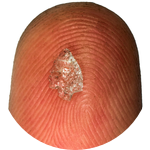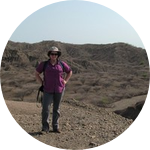About This Project
Humans are the only known species that shape tools from stone. I study the evolution of stone tool-making in the Early Pleistocene archaeological record of Kenya. I will create and analyze experimental stone tool collections to understand how these archaeological artifacts were made. These experimental data will serve as a comparison to the archaeological artifacts, providing insight into how the ancient tools were shaped by our human ancestors.
Ask the Scientists
Join The DiscussionWhat is the context of this research?
More than any other species, humans rely on technology that they design. How did we evolve to be this way? The Early Pleistocene (2.5 to 0.7 million years ago) was a period of drastic change in eastern Africa in environments, human ancestors' anatomy, and in stone tool shapes. Large Cutting Tools (LCTs) are viewed as the first evidence of stone tool shaping (1.8 million years ago). LCT variation, and the overall idiosyncratic nature of shaping, provides challenges to understanding the evolution of shaping behaviors. On Lake Turkana’s western shore (in Kenya), the Kokiselei Site Complex comprises rich stone tool assemblages, including the earliest known LCTs. Thus, Kokiselei is a logical focus for investigating changes in stone tool-making during the evolution of shaping behavior.
What is the significance of this project?
Humans shape the world around them in ways that exceed any other living species - we can change entire landscapes with our technologies. Why and how have we evolved to be this way? The only way we can address these questions is through studying the stone tools that our ancestors left behind. We can test hypotheses about the evolution of shaping by comparing the archaeological artifacts to experimentally created sets of stone tools. Our goal is to understand whether or not human ancestors could have intentionally shaped their tools at Kokiselei, rather than breaking them ad hoc. Few investigations address the evolution of stone tool shaping, and even fewer use experimental models. My project seeks to fill this void and tests the assumption that the earliest LCTs must have been shaped.
What are the goals of the project?
I will collect data from Dr. Reti's experimental stone tool assemblage that I will compare to the archaeological stone tools from Kokiselei. I will collect this data for 4 weeks in January/February 2017. I will record qualitative and quantiative variables from this experimental collection. These data will help determine which variables distinguish physical traits of tools made by specific behaviors. I will expand the experimental collection in a replication experiment in the Spring 2017, using stones that I collected from sources near to the Kokiselei sites. During the summer and fall 2017, I will compare data from the Kokiselei archaeological stone tools with these experimental datasets to test hypotheses about early shaping behavior.
Budget
I will be working with Dr. Jay Reti, using his experimental stone tool assemblage as a comparison to the archaeological stone tool assemblages in my dissertation. I will travel to Dr. Reti's lab in Santa Cruz, CA to collect this data, using my own methodology tailored to understanding my research questions. I've already successfully raised the funds for this part of the research - amazing!
The next stage of research is to travel to Nairobi, Kenya to collect the rest of my archaeological artifact data at the museum. I've added a new stretch budget item to raise funds for my flight to Kenya.
External funds for the larger dissertation project have been provided by the Social Sciences and Humanities Research Council of Canada and by Sigma Xi. I am applying for further funding from the Wenner-Gren and Leakey Foundations.
Endorsed by
Meet the Team
Hilary Duke
My love for digging in the dirt started at age 3. Eventually I became an undergraduate student in archaeology at the University of Toronto in Canada. My first field experience took place in South Africa, and from then on I was committed to the archaeology of human origins in Africa.
I am now a Ph.D. Candidate in Anthropological Sciences. I conduct my research in the Archaeology of Technology Lab with my supervisor, Prof. John Shea, and conduct field research with Dr. Sonia Harmand as a member of the West Turkana Archaeological Project.
My research investigates the evolution of the uniquely human ability to transform stone into shaped tools. I focus on stone tools from the Early Pleistocene archaeological record of eastern Africa, specifically in West Turkana, Kenya.
Additional Information
Dr. Reti's experimental stone tools were created using a "least effort" approach, meaning they were created using as little planning ahead as possible. This is likely the most basic way that human ancestors made their flake tools, and is the opposite of intentionally shaping a stone tool into a specific form (e.g., a handaxe).
My project design will test whether the stone tools from Kokiselei could have been made by this "least effort" approach. Rather than assuming certain types of stone tools (e.g., LCTs) must have been intentionally shaped, I will use experimental data to rule out alternative possibilities.
Collaborating with Dr. Reti is a unique opportunity in which we can build an experimental model for "least effort" stone tool-making in the Early Pleistocene archaeological record of eastern Africa. Dr. Reti's large experimental baseline is the perfect jump-off point for my research design. His assemblage is directly comparable to Early Pleistocene sites in Tanzania (Olduvai Gorge) and northeastern Kenya (Koobi Fora), while my replication experiment will be comparable to archaeological sites in northwestern Kenya. We have a unique opportunity to create a highly replicable, and potentially generalizable, experimental model that can aid in archaeological interpretations addressing a wide range of questions.
Project Backers
- 63Backers
- 132%Funded
- $3,038Total Donations
- $47.47Average Donation


